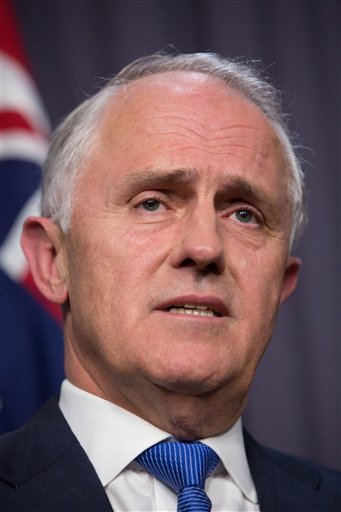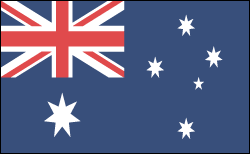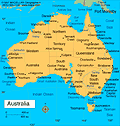Geography
The continent of Australia, with the island state of Tasmania, is approximately equal in area to the United States (excluding Alaska and Hawaii). Mountain ranges run from north to south along the east coast, reaching their highest point in Mount Kosciusko (7,308 ft; 2,228 m). The western half of the continent is occupied by a desert plateau that rises into barren, rolling hills near the west coast. The Great Barrier Reef, extending about 1,245 mi (2,000 km), lies along the northeast coast. The island of Tasmania (26,178 sq mi; 67,800 sq km) is off the southeast coast.
Government
Democracy. Symbolic executive power is vested in the British monarch, who is represented throughout Australia by the governor-general.
History
The first inhabitants of Australia were the Aborigines, who migrated there at least 40,000 years ago from Southeast Asia. There may have been between a half million to a full million Aborigines at the time of European settlement; today about 350,000 live in Australia.
Dutch, Portuguese, and Spanish ships sighted Australia in the 17th century; the Dutch landed at the Gulf of Carpentaria in 1606. In 1616 the territory became known as New Holland. The British arrived in 1688, but it was not until Captain James Cook's voyage in 1770 that Great Britain claimed possession of the vast island, calling it New South Wales. A British penal colony was set up at Port Jackson (what is now Sydney) in 1788, and about 161,000 transported English convicts were settled there until the system was suspended in 1839.
Free settlers and former prisoners established six colonies: New South Wales (1786), Tasmania (then Van Diemen's Land) (1825), Western Australia (1829), South Australia (1834), Victoria (1851), and Queensland (1859). Various gold rushes attracted settlers, as did the mining of other minerals. Sheep farming and grain soon grew into important economic enterprises. The six colonies became states and in 1901 federated into the Commonwealth of Australia with a constitution that incorporated British parliamentary and U.S. federal traditions. Australia became known for its liberal legislation: free compulsory education, protected trade unionism with industrial conciliation and arbitration, the secret ballot, women's suffrage, maternity allowances, and sickness and old-age pensions.
From the World Wars to the End of the Millennium
Australia fought alongside Britain in World War I, notably with the Australia and New Zealand Army Corps (ANZAC) in the Dardanelles campaign (1915). Participation in World War II helped Australia forge closer ties to the United States. Parliamentary power in the second half of the 20th century shifted between three political parties: the Australian Labour Party, the Liberal Party, and the National Party. Australia relaxed its discriminatory immigration laws in the 1960s and 1970s, which favored Northern Europeans. Thereafter, about 40% of its immigrants came from Asia, diversifying a population that was predominantly of English and Irish heritage. An Aboriginal movement that grew in the 1960s gained full citizenship and improved education for the country's poorest socioeconomic group.
In March 1996, the opposition Liberal Party–National Party coalition easily won the national elections, removing the Labour Party after 13 years in power. Pressure from the new, conservative One Nation Party threatened to reduce the gains made by Aborigines and to limit immigration.
In Sept. 1999, Australia led the international peacekeeping force sent to restore order in East Timor after pro-Indonesian militias began massacring civilians to thwart East Timor's referendum on independence.
Changes in Immigration Policy
John Howard won a third term in Nov. 2001, primarily as the result of his tough policy against illegal immigration. This policy has also brought him considerable criticism: refugees attempting to enter Australia—most of them from Afghanistan, Iran, and Iraq and numbering about 5,000 annually—have been imprisoned in bleak detention camps and subjected to a lengthy immigration process. Asylum-seekers have staged riots and hunger strikes. Howard has also dealt with refugees through the “Pacific solution,” which reroutes boat people from Australian shores to camps in Papua New Guinea and Nauru. In 2004, however, the government began easing its policies on immigration.
Australia on the International Stage as Peacekeeper
Prime Minister Howard sent 2,000 Australian troops to fight alongside American and British troops in the 2003 Iraq war, despite strong opposition among Australians.
In July 2003, Australia successfully restored order to the Solomon Islands, which had descended into lawlessness during a brutal civil war.
Australian citizens have been the victims of two significant terrorist attacks in recent years: the 2002 Bali, Indonesia, bombings by a group with ties to al-Qaeda in which 202 died, many of whom were Australian, and the 2004 attack on the Australian embassy in Indonesia, which killed ten.
In Oct. 2004, Howard won a fourth term as prime minister. When rival security forces in East Timor began fighting each other in 2006, Australia sent 3,000 peacekeeping troops to stem the violence. Howard was defeated by the Labor Party's Kevin Rudd in elections in Nov. 2007. Rudd campaigned on a platform for change, and promised to focus on the environment, education, and healthcare. Observers predicted Rudd would maintain a close relationship with the United States. The military began withdrawing Australia’s 550 troops from Iraq in June 2008, following through on a promise made by Rudd.
The worst wildfires in Australian history killed at least 181 people in the state of Victoria, injured more than a hundred, and destroyed more than 900 houses in Feb. 2009. At least one of the fires was determined to be the work of arsonists. Australian officials were criticized for failing to evacuate those in danger. A government inquiry was requested to research the state's response to the fires.
Australia Elects Its First Female Prime Minister
Rudd's popularity plummeted in May 2010, largely because he shelved his environmental policy that centered on an emissions-trading system. In June, the Labor Party ousted him as its leader and elected his deputy, Julia Gillard. She became Australia's first female prime minister in June and promptly called for elections, which were held in August. They resulted in a hung parliament, with neither the incumbent Labor Party nor the conservative Liberal-National coalition, led by Tony Abbott, taking a majority of seats. It is the country's first hung parliament in 70 years. After several weeks of attempting to woo members of parliament to her side, Gillard succeeded in early September, when two independents backed her. It was enough to give her the slimmest majority: 76 out of 150 seats.
Worst Flooding in Decades
In Jan. 2011, the worst flooding for decades in Queensland cut off many cities and towns. The floods left more than 30 people dead and caused billions of dollars in damage to mines, farms, and cities. Coal mining operations in the Australian state were severely hampered. The flood affected about 200,000 people and covered an area larger than France and Germany combined. Prime Minister Gillard started off the New Year by visiting the ravaged state. In April, Queensland urban areas were plagued with extremely large numbers of flying beetles, a likely result of the floods.
U.S. Establishes Military Presence
Nov. 2011 saw Barack Obama in Canberra where he announced a new American military presence near the port city of Darwin, "Australia's Pearl Harbor." Marines will be gradually deployed over the coming years, to a total strength of 2,500. Mr. Obama's speech established his commitment to "a larger and long-term role" in shaping the region, which will include providing humanitarian relief and responding to security issues in Southeast Asia and the South China Sea.
Wildfires and Record High Temperatures Strike in Early 2013
In Jan. 2013, summer for Australia, wildfires spread throughout the southeastern part of the country. National parks were evacuated as temperatures reached 113 degrees Fahrenheit. The extremely high temperatures mixed with dry and windy conditions combined to raise the threat level to catastrophic, the most severe rating.
Since Sept. 2012, Australia has experienced record-breaking heat. Four months later, the country was having its hottest summer on record. So far there were no confirmed deaths due to the wildfires, but 100 people were missing after a fire raged through Dunalley, Tasmania, and destroyed approximately 90 homes. Thousands of sheep and cattle have been killed after the fires roared through some of the country’s biggest farming regions. As of Jan. 9, 2013, at least 141 fires were burning in the state of New South Wales alone.
Gillard Resigns after Losing Party Leadership
On June 26, 2013, Prime Minister Julia Gillard resigned after being ousted as Labor Party leader in a party vote. Former Prime Minister Kevin Rudd replaced her as party leader and, the following day, replaced her as prime minister. It was a dramatic turn of events and ironic because it was Gillard who replaced Rudd as Labor Party leader in 2010.
Gillard called the vote in late June to avoid a challenge from Rudd and his supporters. Rudd's support was steadily growing due to the party's recent poor poll results under Gillard's leadership. The polls were predicting terrible losses for the Labor Party in upcoming elections. During a news conference after the vote, Gillard said, "I am pleased that in this environment, which wasn't easy, I have prevailed to ensure that this country is made stronger, and smarter, and fairer for the future." Gillard also said that it was a privilege to serve as Australia's first female prime minister.
Worst Fire Emergency in almost 50 Years
In Oct. 2013, the state of New South Wales was faced with its worst fire emergency in almost 50 years. Dozens of fires broke out across the state. As of October 22, 2013, 60 fires still burned, and 14 of those were described as out of control. Just west of Sydney, two fires merged into one mega fire. Thick smoke reached as far as Sydney's famous opera house. So far 200 homes have been destroyed. Many more have been damaged.
According to Australia's Bureau of Meteorology, 2013 would most likely become the hottest year on record in the country. Sept. 2013 was Australia's hottest September ever. Little rain and high winds added to the extreme situation. While the fires raged in New South Wales, United Nations Climate Chief Christiana Figueres said, "The World Meteorological Organization has not established the direct link between this wildfire and climate change yet, but what is absolutely clear is that the science is telling us there are increasing heat waves in Asia, Europe and Australia."
Abbott Named Prime Minister
In the Sept. 2013 federal elections, the incumbent Labor Party, led by Prime Minister Kevin Rudd was defeated by the Liberal/National Coalition opposition. The Liberal/National Coalition was led by Tony Abbott of the Liberal Party of Australia. A Member of Parliament since 1994, Abbott was sworn in as prime minister on Sept. 18, 2013.
On Jan. 28, 2014, Peter Cosgrove was named to succeed Governor-General Quentin Bryce. A retired Army officer, Cosgrove served as Chief of the Defence Force from July 2002 to July 2005.
Armed Man Holds Hostages in Sydney Cafe
In Dec. 2014, an armed man held 17 employees and customers hostage for more than 16 hours in a downtown Sydney cafe. The armed man was identified as Man Haron Monis, an Iranian-born, 50-year-old man with a criminal record.
After being held for 16 hours, six hostages escaped the cafe. Soon after, gunshots were heard inside and police stormed the building. Three people were killed, including two hostages and Monis.
Turnbull Replaces Abbott as Prime Minister

Prime Minister Malcolm Turnbull
Source: AP Photo/Andrew Taylor
Two years after he was elected, Prime Minister Tony Abbott was replaced by Malcolm Turnbull. In Sept. 2015, Turnbull challenged Abbott for the Liberal Party leadership and won by a vote of 54-44. Turnbull became Australia's 29th prime minister on Sept. 15, 2015.
A former journalist, lawyer, and banker, Turnbull, age 60, faced a divided government, stalled economy, and low public opinion as he took office. More centrist than Abbott, and a supporter of same-sex marriage, Turnbull wrote in a 2015 blog post that "it would be better if same-sex marriage were not a contentious issue at the next election." Also a supporter of climate change, Turnbull wrote in a 2010 opinion piece that, "Climate change is the ultimate long term problem. We have to make decisions today, bear costs today so that adverse consequences are avoided, dangerous consequences, many decades into the future."
See also Australian dependencies.
See also Encyclopedia: Australia .
U.S. State Dept. Country Notes: Australia
Australian Bureau of Statistics www.abs.gov.au/











